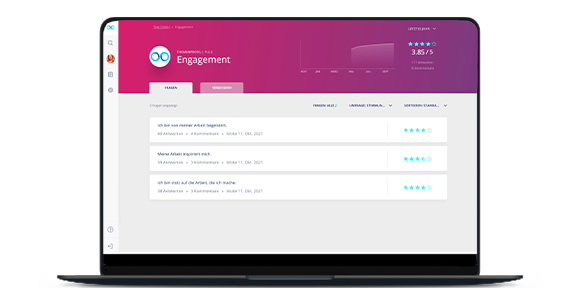
Leverage Conflicts - even in Hybrid Settings
31.03.2023
Even without the component of hybrid working, conflicts in the workplace can quickly arise. Factors such as different priorities, opinions, or areas of expertise can all serve as potential ground for friction - and that's not only a bad thing! After all, constructive exchanges and diverse perspectives will almost always result in better outcomes. Once conflicts are not resolved and, in the worst case, escalated there is a need for action.
On top of this already delicate matter, we are now excessively working in hybrid setups. In terms of one team alone, this means that while Manuel and Antonia sit together in the office twice a week, Linda and Cole mainly work from home. Lucas, on the other hand, values local flexibility and switches between working from home, the office, and abroad.
The result? Video calls are on our daily schedule and serve as most relevant source to quickly discuss and resolve tasks. The rest is discussed via e-mails and chats. So not only is the in-person exchange lost, but with it gestures, facial expressions and context.
Conflict Management per Definition
Let's build a common understanding: A conflict is defined as a situation, in which two or more parties have opposing goals, interests or views and try to enforce them. A conflict often arises from a lack of communication or misunderstandings. The extent of a conflict can differ significantly based on the underlying issue, since professional differences are easier to resolve than those based on different value systems.
When it comes to resolving conflicts, it makes a lot of sense to have a deeper look at conflict management methods, focusing on identifying, preventing, evaluating and resolving conflicts. The goal here is to find reconciliations of interests - usually a compromise between the parties - so that a good cooperation from there onwards can be sustained.
While the team naturally plays a role, it is primarily the manager who is in charge of an open communication, act with empathy and creativity towards conflict resolution. Effective conflict management results in a more efficient exchange within teams and reduces stress.
Case studies: Conflicts at work
Conflicts in the workplace can be just as multi-layered as in the personal environment. Even very factual conflicts can be fueled through differing interpersonal components. We have prepared three case studies representing common, relatable conflict situations.
- Personal conflicts are based on differences in personality, work style, opinions or value systems. While specific actions or statements are often the source for such conflicts, assumptions and generalizations may also play a role. This is why we also speak of subconscious conflicts. Let's picture a conversation, in which Lisa expresses her opinion about the gender pay gap and the underlying social constructs. While there's no conflict at first, Tim feels uncomfortable with the topic and defensively classifies Lisa as the "classic feminist" from here on. This in turn can likely create critical situations.
- Conflicts of interest or factual conflicts are part of everyday work and describe divergent views on technical issues. Which feature should be prioritized in the upcoming sprint? Which marketing mix is serving our corporate vision? Who is in the lead at which points? The more factual things are, the easier it is to resolve them.
- Power conflicts: If employees do not feel comfortable with their manager, this can have a variety of reasons. Perhaps they feel that they are not being treated fairly or with respect. Or maybe it's about difference in expectations and actual performance. Or perhaps it's merely misunderstandings - i.e. communication problems - that are the root of the problem.
Conflict Resolution Strategies
The longer a conflict exists, the higher the likelihood of escalation. Even with subconscious conflicts, which go unnoticed for a long time, it is essential that managers recognize them ahead of time and take action. There are, of course, different approaches to addressing conflicts depending on type and severity of the situation. We'll stick to the categories mentioned above.
Personal Conflicts
The first example presents a subconscious conflict between Tim and Lisa based on different value systems and complex social structures. Such a situation can be very challenging. First of all, as a manager, it is important to be empathetic enough to recognize the problem in the first place and to react at an early stage.
The source of the conflict lies in the conversation about topics related to existing gender pay gaps. This alone provides ground for action already, since at least one person in the team is very invested in the topic, and other teammates are less familiar with it. One way to go about: Setting up a (flexible) monthly meeting to discuss a topic relevant to team members. By giving everyone the opportunity to prepare, a constructive exchange can develop. This promotes communication and understanding for each other.
But once negative comments or tensions become apparent, managers have to intervene. At this point, it makes sense to talk to both parties individually to get an initial feeling for the situation. Followed by a conversation between all parties to give room for diverging opinions, resolve the tension and prepare an action sheet for future conflicts.
Conflicts of Interest
As mentioned before, these types of conflicts are relatively easy to resolve. Let's take the example of prioritizing either feature A or B in the upcoming sprint.
- What do the customers want?
- What is the market asking for?
- Which feature development needs more resources?
- Are there current market trends to be aware of?
These and similar questions should be asked to take the decision in favour of overall business success, regardless of personal preferences.
Power Conflicts
Back to a conflict that tends to be very challenging again. Personal conflicts already play a big part in hierarchical settings, and personal differences have the potential to increase those dynamics even more. Per usual, managers are in the lead to make team members feel comfortable for them to perform at their best.
The best tool to start with: regular feedback cycles. This setting provides both parties with time to prepare for a constructive exchange and gives room to address any challenges in working together. Of course, it is important to provide the space for this and be open to criticism.
At the same time we know: as a manager, but especially as a team member, it can be insanely difficult to express criticism based on different value systems or specific statements. Our tips:
- Prepare and practice wording. This ensures a clear message and provides certainty, which in turn helps the other party understand.
- Anticipate and classify possible criticism. This makes it easier to accept the criticism at the moment of the conversation and to act directly in a solution-oriented manner.
- Make your own suggestions to improve the cooperation.
If, contrary to expectations, the situation does not improve, it is worth involving a third party and, in case of doubt, even HR.
Leverage Conflicts
Conflicts follow three stages (Friedrich Glasl):
- Win-Win: In this first phase, discussions and tensions occur, however, these conflicts can still be resolved constructively. By focusing on an exchange and working together to find a solution, both parties win in the end.
- Win-lose: At this point, the conflict is no longer about the conflict itself, but about who wins. Meaning, there are power games and the focus is on saving face. One of the two parties loses in this phase. And above all, the working atmosphere and productivity suffer.
- Lose-lose: If it gets to the last phase, both parties only want to harm each other and even put their own position in the company at risk.
We summarize: As long as we are in the first phase, i.e. the win-win phase, conflicts can have positive effects. The need for optimization is identified, constructive exchange is promoted and workflows are improved. The be-all and end-all is to recognize early on and react accordingly.
And this is where the circle closes, because it is becoming increasingly difficult to recognize tensions ahead of time, especially in hybrid settings. So having an early warning system in place makes all the difference. Naturally, we'll throw in pulse checks at this point, because this really can make all the difference.



